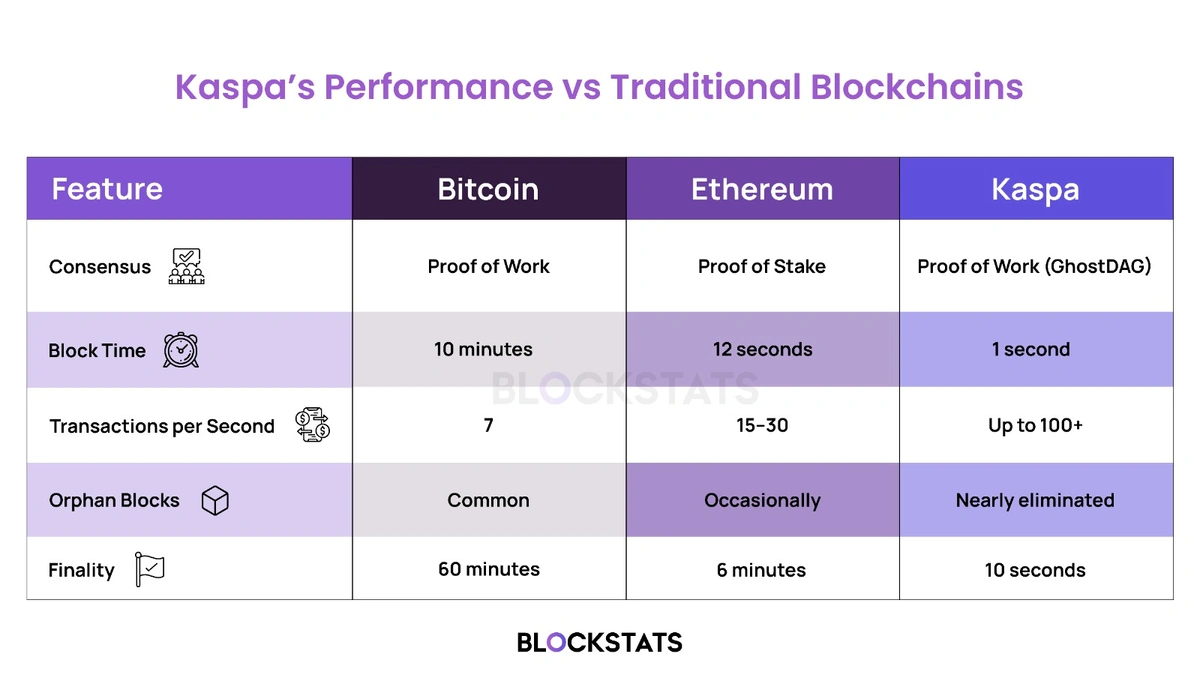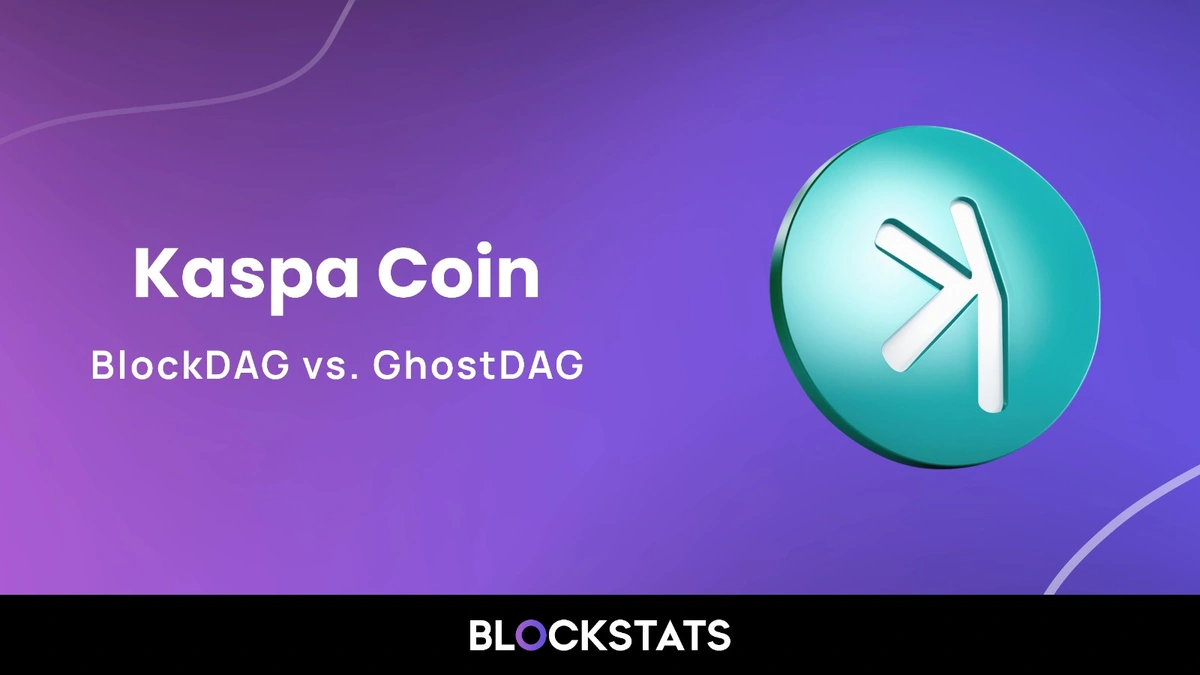Kaspa Coin Explained: BlockDAG vs. GhostDAG
The blockchain world is evolving fast, and with it comes a new wave of innovations designed to overcome the limitations of older systems. One name that's been gaining serious traction is Kaspa (KAS)—a Proof-of-Work cryptocurrency that is rewriting the rules of speed, scalability, and decentralization. Kaspa is more than just another cryptocurrency—it is a bold step toward a faster, fairer, and truly decentralized future.
At Blockstats, we are closely tracking Kaspa’s rapid growth and performance. This blog breaks down what makes Kaspa unique, how its core technologies work, and why it’s becoming a project to watch in the crypto space.
What is Kaspa Coin?
Kaspa (KAS) is a rapidly growing cryptocurrency that brings a breakthrough in blockchain performance through a structure called BlockDAG and a consensus mechanism known as GhostDAG. In contrast, traditional cryptocurrencies that rely on a linear chain of blocks, Kaspa’s architecture enables extremely high throughput, near-instant confirmations, and supreme decentralization—all without sacrificing security. Kaspa is designed for those who believe blockchain should scale globally while still remaining fast, secure, and censorship-resistant.
Understanding the Limitations of Traditional Blockchain
Traditional blockchain systems offer security and decentralization but often struggle with scalability, speed, and high energy consumption. To truly appreciate Kaspa, let’s briefly look at the problems it aims to solve:
-
Slow block times: Bitcoin has a block time of 10 minutes. Ethereum, around 12 seconds. This slows down transactions and leads to network congestion.
-
Low throughput: Most blockchains can process only a limited number of transactions per second (TPS), making them inefficient for large-scale adoption.
-
Orphaned blocks: In traditional Proof-of-Work chains, when two blocks are mined simultaneously, one is discarded. This leads to wasted energy and lost rewards. Kaspa changes this paradigm completely.
BlockDAG: A New Era of Blockchain Architecture
A BlockDAG (Block Directed Acyclic Graph) is not a blockchain in the traditional sense. Instead of a single, linear chain of blocks, it allows for multiple blocks to be created and added simultaneously. Imagine a web of blocks branching and merging instead of a single straight line.
How BlockDAG Works in Kaspa?
-
Multiple miners can create blocks at the same time.
-
All valid blocks are recorded, reducing orphaning.
-
The structure forms a directed graph, not a single chain.
Key Benefits of BlockDAG
- Higher Throughput: More transactions processed in parallel.
- Reduced Orphan Blocks: Compared to Bitcoin, few blocks go to waste.
- Decentralization: BlockDAG supports more miners without centralizing the network.
This architecture is important for enabling scalability without giving up decentralization.
GhostDAG: The Foundation That Makes It All Work
While BlockDAG allows for multiple blocks to exist at once, it introduces a major challenge: How do you decide the correct order of transactions when blocks are added out of sync? That is where GhostDAG comes in.
GhostDAG (Greedy Heaviest Observed SubTree DAG) is Kaspa’s decision-making protocol that organizes and ranks the blocks in the DAG structure.
How GhostDAG Works?
-
It does not discard blocks as long as they follow protocol rules.
-
It ranks blocks based on their connection and "weight" in the DAG.
-
It maintains a “blue set” (preferred blocks) and a “red set” (less preferred blocks) for ordering.
Key Benefits of GhostDAG
Kaspa can process 100+ blocks per second without centralization—something no traditional blockchain can achieve with proof of work.
- Fairness in Mining: More blocks are accepted, ensuring that miners' efforts are always rewarded, minimizing wasted work.
- Secure Consensus: GhostDAG ensures that even with multiple blocks per second, consensus stays consistent and safe.
- Instant Confirmation: Transactions can be confirmed within seconds.
- Scalability Without Compromise: GhostDAG's ability to handle high transaction volumes while maintaining security.
Kaspa’s Performance vs. Traditional Blockchains

Why Kaspa is a Game-Changer?
Kaspa combines the security of Bitcoin, the speed of modern DAG-based protocols, and the decentralization ethos of open-source crypto. It is among the few Proof-of-Work projects that have effectively addressed scalability without resorting to centralized solutions or layer-2 hacks.
Real-World Use Cases of Kaspa:
-
Microtransactions: With instant and low-cost transfers, Kaspa is perfect for daily payments.
-
Developer-Friendly: Open-source and built for integration.
-
Energy-Efficient Mining: Optimized to work with existing hardware without extreme power consumption.
BlockDAG vs. GhostDAG: Quick Recap
|
Aspect |
BlockDAG |
GhostDAG |
|
Role |
Data structure for multiple blocks |
Consensus protocol to order blocks |
|
Problem Solved |
Block time bottlenecks |
Fair and secure ordering of simultaneous blocks |
|
Unique Feature |
Supports multiple simultaneous blocks |
Classifies and orders all blocks fairly |
|
Used By |
Kaspa, Fantom, Conflux (varied versions) |
Only Kaspa (GhostDAG is unique) |
Experience Kaspa Like Never Before with Blockstats!
Kaspa is redefining what is possible in blockchain with its unique architecture—by using Blockstats, Kaspa coin holders, developers, and miners can better understand the operational efficiency of the Kaspa network. This transparency builds trust in the network's security, scalability, and decentralization.
